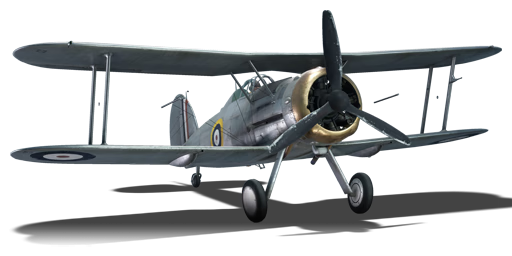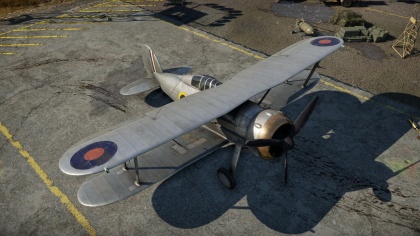Difference between revisions of "Gladiator Mk IIS"
Colok76286 (talk | contribs) |
|||
| Line 263: | Line 263: | ||
{{AirManufacturer Gloster}} | {{AirManufacturer Gloster}} | ||
{{Britain fighters}} | {{Britain fighters}} | ||
| − | |||
Revision as of 15:41, 18 May 2020
Contents
| This page is about the gift British fighter Gladiator Mk IIS. For other versions, see Gladiator (Family). |
Description
The Gladiator Mk IIS is a gift rank I British fighter
with a battle rating of 1.7 (AB) and 1.3 (RB/SB). It used to be a part of Britain's reserve aircraft before it and the Gladiator Mk IIF was removed and replaced by the Fury and Nimrod aircraft. Unlike the Mk IIF, the Mk IIS was offered once during the "Gladiator Glory!" event in February 2015 and has since been unavailable to the public.
At Rank I and a battle rating of with a battle rating of 1.7 (AB) and 1.3 (RB/SB), this plane will typically be one of the first fighters a new player will research. However, the Gladiator, like its sea-based cousin, may be difficult to seek success in, especially in realistic battles mode. Within realistic battles, when up-tiering comes into play, it will have to deal with not only biplane adversaries such as the CR.42, F3F and the very manoeuvrable Ki-10, but also more advanced fighters such as the P-40E, Bf 109s, I-16s, and Ki-43s. All these plane types have several varying advantages against the Gladiator, which can make early grinding a bit unbearable for some players.
General info
Flight Performance
Describe how the aircraft behaves in the air. Speed, manoeuvrability, acceleration and allowable loads - these are the most important characteristics of the vehicle.
| Characteristics | |||||||
|---|---|---|---|---|---|---|---|
| Stock | |||||||
| Max Speed (km/h at 4,420 m) |
Max altitude (meters) |
Turn time (seconds) |
Rate of climb (meters/second) |
Take-off run (meters) | |||
| AB | RB | AB | RB | AB | RB | ||
| 395 | 388 | 10,211 | 17.0 | 17.3 | 12.5 | 12.5 | 232 |
| Upgraded | |||||||
| Max Speed (km/h at 4,420 m) |
Max altitude (meters) | Turn time (seconds) | Rate of climb (meters/second) |
Take-off run (meters) | |||
| AB | RB | AB | RB | AB | RB | ||
| 435 | 414 | 10,211 | 15.0 | 16.0 | 22.3 | 15.7 | 232 |
Details
| Features | ||||
|---|---|---|---|---|
| Combat flap | Take-off flap | Landing flap | Air brakes | Arrestor gear |
| ✓ | ✓ | ✓ | X | X |
| Limits | ||||
|---|---|---|---|---|
| Wing-break speed (km/h) |
Gear limit (km/h) |
Combat flap (km/h) |
Max Static G | |
| + | - | |||
| 560 | 450 | 520 | ~12 | ~6 |
| Optimal velocities | |||
|---|---|---|---|
| Ailerons (km/h) |
Rudder (km/h) |
Elevators (km/h) |
Radiator (km/h) |
| < 300 | < 380 | < 380 | > 190 |
| Compressor (RB/SB) | ||
|---|---|---|
| Setting 1 | ||
| Optimal altitude | 100% Engine power | |
| 4,160 m | 840 hp | |
Survivability and armour
- No armour plating
- No armour glazing
- Critical components located in front of aircraft (fuel, pilot, engine, controls)
- More fuel tanks located in wings near fuselage
Armaments
Offensive armament
The Gladiator Mk IIS is armed with:
- 2 x 7.7 mm Browning .303 machine gun, fuselage-mounted (600 rpg = 1,200 total)
- 2 x 7.7 mm Browning .303 machine gun, fuselage-mounted (400 rpg = 800 total)
Usage in battles
The Gladiator has four 7.7 mm (.303) Browning machine guns with a total of 2,000 rounds on hand. As with most other 7.7 mm guns, the default rounds for the Brownings can be a bit weak in stopping power, but when equipped with tracer belts the four guns on this plane can be a deadly force to be reckoned with, as they can trigger fires and do a considerable amount of damage as a result.
There are a couple of issues with the Gladiator, all of which can make it an easy target at times:
- Its power plant configuration, which includes an engine with no WEP capability and a three-blade fixed-pitch propeller, can make the Gladiator a slug in acceleration and climb. In-flight testing the Gladiator can usually only sustain at most around 3,000 fpm (roughly 15 m/s) in a climb at around 180-200 kph (111-124 mph) indicated airspeed, and its top speed isn't great either (at sea level it can only manage around 335 kph, and testing has yielded 396 kph at 4,000 m altitude).
- The Gladiator manoeuvres well. However, it bleeds a lot of speed in sharp turns, and while its turn radius is good enough to shake off reserve planes, the loss of speed can make the plane a slower and henceforth more vulnerable target to any other enemy planes in the area. Using flaps does help a bit with decreasing the amount of speed lost in a turn, but it is not beneficial enough to allow for minimal loss of speed. And like most early British fighters, it hates high speeds in dives.
However, the Gladiator's four Browning armament can come in handy at times when equipped with tracer belts, the plane is capable of taking down even the fiercest of opponents if you play your cards right. A good approach to combat is to attempt to side climb as much as you can on any given map, then use your altitude advantage and turn advantage wisely.
Manual Engine Control
| MEC elements | ||||||
|---|---|---|---|---|---|---|
| Mixer | Pitch | Radiator | Supercharger | Turbocharger | ||
| Oil | Water | Type | ||||
| Controllable | Not controllable | Not controllable | Not controllable | Separate | Not controllable | Not controllable |
Modules
| Tier | Flight performance | Survivability | Weaponry | ||
|---|---|---|---|---|---|
| I | Fuselage Repair | Radiator | Offensive 7 mm | ||
| II | Compressor | Airframe | New 7 mm MGs | ||
| III | Wings Repair | Engine | |||
| IV | Engine Injection | Cover | |||
Pros and cons
Pros:
- Armament is equal to or better than other fighters in its battle rating
- Good manoeuvrability in a turn
- Tracer belts, like all other planes fitted with Browning machine guns, can be deadly
- Has flaps, unlike most other biplane fighters
Cons:
- Sluggish in acceleration and top speed (fixed-pitch propeller and lack of WEP can emphasize this problem)
- Performance deficiencies can make it an easy target for experienced or more difficult adversaries
- Not the best climber
- Bleeds speed in turns, even when using flaps
History
Describe the history of the creation and combat usage of the aircraft in more detail than in the introduction. If the historical reference turns out to be too long, take it to a separate article, taking a link to the article about the vehicle and adding a block "/ History" (example: https://wiki.warthunder.com/(Vehicle-name)/History) and add a link to it here using the main template. Be sure to reference text and sources by using <ref>, as well as adding them at the end of the article. This section may also include the vehicle's dev blog entry (if applicable) and the in-game encyclopedia description (under === Encyclopedia Info ===, also if applicable).
In-game description
"The Gloster Gladiator was a single engine, single seat fighter which entered service in 1937 as the Royal Air Force’s last biplane fighter. Often overshadowed by more modern monoplanes, it still remained arguably the greatest biplane fighter of all time.
Biplane design was already considered outdated by the time production of the Gladiator started, but it was feared that Britain might not have time to develop more modern monoplanes in sufficient quantities before full scale war began.
Building on the success of the earlier Gauntlet fighter, the Gladiator was developed to replace the aging Bristol Bulldog. Featuring an enclosed cockpit, new wings and a more streamlined fixed undercarriage, the armament was also increased to four 0.303 inch machine guns. Initially, 231 Gladiator Mk Is were delivered to the RAF.
The Mk II model had the more reliable Bristol Mercury VIIIA / AS engine with an output of 830 horsepower in place of the Mk I’s Mercury IX; this was also fitted with an electrical starter motor, automatic mixture control, Vokes air filter and a metal three bladed propeller to replace the earlier wooden two bladed variant. 38 Gladiator Mk IIs were also fitted with arrestor hooks to serve in the Fleet Air Arm as Sea Gladiators until 60 fully navalised variants were also delivered, the latter being fitted with catapult points and a dinghy stowage.
A total of 746 Gladiator aircraft were produced, and served with distinction in the opening phases of the war, notably during the Norwegian Campaign and in the defence of Malta. Pilots who achieved success in the Gladiator included the RAF’s top scorer, Squadron Leader ‘Pat’ Pattle, who scored 15 ½ confirmed kills in Gladiators, and Royal Navy Commander Charles Keighly-Peach, who trained several of his Swordfish pilots in fighter tactics to operate from HMS Eagle in the Mediterranean."
Media
See also
Links to the articles on the War Thunder Wiki that you think will be useful for the reader, for example:
- reference to the series of the aircraft;
- links to approximate analogues of other nations and research trees.
External links
| Gloster Aircraft Company, Limited | |
|---|---|
| Fighters | Gladiator Mk II · Sea Gladiator Mk I · Gladiator Mk IIF · Gladiator Mk IIS · Tuck's Gladiator Mk II |
| Jet Fighters | Meteor F Mk 3 · Sea Meteor F Mk 3 · Meteor F Mk 4 G.41F · Meteor F Mk 4 G.41G · Meteor F Mk 8 G.41K · Meteor F Mk.8 Reaper |
| Javelin F.(A.W.) Mk.9 | |
| Export | J8A · Iacobi's J8A · ␗Gladiator Mk I · ▄Gladiator Mk I |
| ▄Meteor F Mk.8 · Meteor F.8 · Meteor NF.13 | |
| See Also | Fokker |






